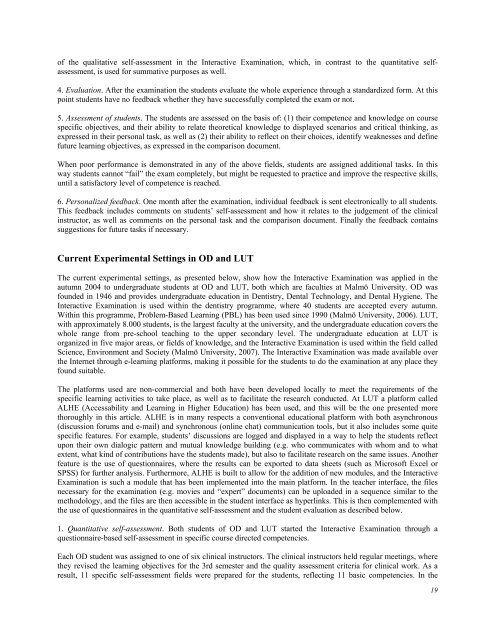October 2007 Volume 10 Number 4 - Educational Technology ...
October 2007 Volume 10 Number 4 - Educational Technology ...
October 2007 Volume 10 Number 4 - Educational Technology ...
You also want an ePaper? Increase the reach of your titles
YUMPU automatically turns print PDFs into web optimized ePapers that Google loves.
of the qualitative self-assessment in the Interactive Examination, which, in contrast to the quantitative selfassessment,<br />
is used for summative purposes as well.<br />
4. Evaluation. After the examination the students evaluate the whole experience through a standardized form. At this<br />
point students have no feedback whether they have successfully completed the exam or not.<br />
5. Assessment of students. The students are assessed on the basis of: (1) their competence and knowledge on course<br />
specific objectives, and their ability to relate theoretical knowledge to displayed scenarios and critical thinking, as<br />
expressed in their personal task, as well as (2) their ability to reflect on their choices, identify weaknesses and define<br />
future learning objectives, as expressed in the comparison document.<br />
When poor performance is demonstrated in any of the above fields, students are assigned additional tasks. In this<br />
way students cannot “fail” the exam completely, but might be requested to practice and improve the respective skills,<br />
until a satisfactory level of competence is reached.<br />
6. Personalized feedback. One month after the examination, individual feedback is sent electronically to all students.<br />
This feedback includes comments on students’ self-assessment and how it relates to the judgement of the clinical<br />
instructor, as well as comments on the personal task and the comparison document. Finally the feedback contains<br />
suggestions for future tasks if necessary.<br />
Current Experimental Settings in OD and LUT<br />
The current experimental settings, as presented below, show how the Interactive Examination was applied in the<br />
autumn 2004 to undergraduate students at OD and LUT, both which are faculties at Malmö University. OD was<br />
founded in 1946 and provides undergraduate education in Dentistry, Dental <strong>Technology</strong>, and Dental Hygiene. The<br />
Interactive Examination is used within the dentistry programme, where 40 students are accepted every autumn.<br />
Within this programme, Problem-Based Learning (PBL) has been used since 1990 (Malmö University, 2006). LUT,<br />
with approximately 8.000 students, is the largest faculty at the university, and the undergraduate education covers the<br />
whole range from pre-school teaching to the upper secondary level. The undergraduate education at LUT is<br />
organized in five major areas, or fields of knowledge, and the Interactive Examination is used within the field called<br />
Science, Environment and Society (Malmö University, <strong>2007</strong>). The Interactive Examination was made available over<br />
the Internet through e-learning platforms, making it possible for the students to do the examination at any place they<br />
found suitable.<br />
The platforms used are non-commercial and both have been developed locally to meet the requirements of the<br />
specific learning activities to take place, as well as to facilitate the research conducted. At LUT a platform called<br />
ALHE (Accessability and Learning in Higher Education) has been used, and this will be the one presented more<br />
thoroughly in this article. ALHE is in many respects a conventional educational platform with both asynchronous<br />
(discussion forums and e-mail) and synchronous (online chat) communication tools, but it also includes some quite<br />
specific features. For example, students’ discussions are logged and displayed in a way to help the students reflect<br />
upon their own dialogic pattern and mutual knowledge building (e.g. who communicates with whom and to what<br />
extent, what kind of contributions have the students made), but also to facilitate research on the same issues. Another<br />
feature is the use of questionnaires, where the results can be exported to data sheets (such as Microsoft Excel or<br />
SPSS) for further analysis. Furthermore, ALHE is built to allow for the addition of new modules, and the Interactive<br />
Examination is such a module that has been implemented into the main platform. In the teacher interface, the files<br />
necessary for the examination (e.g. movies and “expert” documents) can be uploaded in a sequence similar to the<br />
methodology, and the files are then accessible in the student interface as hyperlinks. This is then complemented with<br />
the use of questionnaires in the quantitative self-assessment and the student evaluation as described below.<br />
1. Quantitative self-assessment. Both students of OD and LUT started the Interactive Examination through a<br />
questionnaire-based self-assessment in specific course directed competencies.<br />
Each OD student was assigned to one of six clinical instructors. The clinical instructors held regular meetings, where<br />
they revised the learning objectives for the 3rd semester and the quality assessment criteria for clinical work. As a<br />
result, 11 specific self-assessment fields were prepared for the students, reflecting 11 basic competencies. In the<br />
19

















